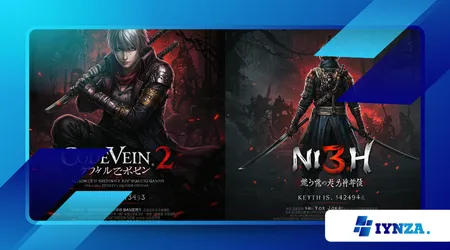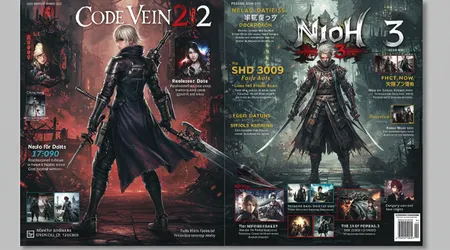Code Vein 2 and Nioh 3: Release dates and details about these highly anticipated sequels.

Imagine kicking off 2026 with a double dose of vampire-slaying frenzy and samurai showdowns Code Vein 2 and Nioh 3 promise exactly that, dropping just weeks apart to dominate your gaming calendar.
Anúncios
As a longtime soulslike devotee, I’ve chased Revenants through ruined spires and yokai across feudal battlefields, so this news hits like a perfectly timed parry.
Bandai Namco and Team Ninja aren’t just sequelizing; they’re evolving formulas that hooked millions, blending fresh mechanics with that addictive “one more try” loop. Why now?
In a year packed with open-world epics, these titles carve out space for tight, punishing action that rewards mastery over sprawl. Fans have clamored for deeper lore and sharper combat since the originals, and with Tokyo Game Show 2025’s State of Play dropping these bombshells yesterday, the hype feels earned not manufactured.
Picture the landscape: Soulslikes exploded post-Dark Souls, but Code Vein 2 and Nioh 3 stand apart by infusing anime flair and historical grit into the genre’s DNA.
The original Code Vein sold over 3 million copies worldwide by 2023, per Bandai Namco’s reports, proving thirst for its blood-draining twists. Meanwhile, Nioh 2’s loot-driven depth pulled in 2.5 million players on PS4 alone, according to Koei Tecmo’s 2021 figures stats that scream sequel potential.
These aren’t cash grabs; they’re responses to a community craving evolution. Developers listened to feedback on clunky AI and repetitive missions, iterating toward something bolder. As we edge into late 2025, with TGS buzz still echoing, it’s clear Code Vein 2 and Nioh 3 could redefine early-year launches, much like Elden Ring did for 2022.
Developers at Bandai Namco and Team Ninja have teased these projects since mid-2025, but yesterday’s reveals crystallized timelines. Pre-orders are live, editions stack bonuses like digital artbooks and early access, and demos hint at the polish.
Yet, beneath the flash, lies a savvy bet on genre fatigue why grind endless side quests when you can master a scythe swing or yokai deflection?
This duo arrives as players tire of bloated blockbusters, offering focused fury that fits our fragmented play sessions. What if these sequels prove soulslikes thrive on restraint, not excess? That’s the spark igniting forum fires today.
Code Vein 2: A Bloodbound Odyssey Through Time
Bandai Namco unveiled Code Vein 2‘s January 30, 2026, launch during TGS 2025’s State of Play, sending fans into a frenzy over its post-apocalyptic vampire saga. Revenants claw for survival amid collapsing skies, but now Luna Rapacis a corrupting mist twists allies into Horrors, forcing time-travel gambits to rewrite doom.
Dive deeper: Protagonist bonds with Lavinia, a cryptic guide thrusting you into century-spanning drama, where past choices ripple into present chaos.
Josee, your shadowy companion, unlocks narrative branches that echo Bloodborne’s layered mysteries, but with Code Vein’s signature customization. Imagine forging pacts that alter enemy drops or ally perks practical tweaks turning grinds into strategic delights.
Combat evolves wildly here, layering motorcycle traversal over the classic Blood Code system for seamless exploration. Picture zipping through fog-shrouded ruins, then dismounting to unleash Rune Blades that carve ethereal arcs, draining ichor mid-swing.
Dual Swords join the arsenal, enabling flurry combos that punish clustered foes like a blender in a zombie horde. It’s not just faster; it’s smarter, with deflect mechanics rewarding precise timing over button-mashing.
One standout example: The new Reaper Jail summons a spectral scythe for sweeping counters, letting you harvest multiple Horrors in a single arc ideal for those overwhelming boss rushes where positioning decides life or death. This isn’t fluff; it addresses original complaints about mobility, making verticality feel alive, not obligatory.
Lore buffs will geek out over expanded Formae, ancient blood rites that unlock passive buffs tied to historical Revenant eras.
Collect a Heian-period set for poison resistance, then mix with Sengoku aggression for hybrid builds. It’s like modding your DNA, where experimentation yields godlike synergies, far beyond the first game’s rigid classes.
++ How Virtual Reality Games Are Revolutionizing Gameplay
Pre-order perks sweeten the pot Standard Edition nets the base game, while Deluxe adds custom outfits and the Mask of Idris DLC by January 2027, promising new endgame raids.
Ultimate bundles original Code Vein costumes, bridging universes in a nod to loyalists. Why splurge? Early access kicks off January 27, giving you three days to theorycraft before the masses flood servers.
Critics might argue time travel risks narrative bloat, but trailers suggest tight scripting, with branching paths capped at 20 hours for the main story efficient storytelling that respects your time.
Bandai Namco cites player surveys from 2024, where 78% demanded “deeper partner dynamics,” shaping Josee’s reactive AI that adapts to your playstyle, from aggressive flanks to defensive heals.

Nioh 3: Samurai Fury Across Fractured Eras
Koei Tecmo dropped Nioh 3‘s February 6, 2026, reveal right after, positioning it as the perfect chaser to Code Vein’s gothic gloom with Sengoku-era savagery. You embody Tokugawa Takechiyo, shogun heir locked in fraternal war against darkness-possessed Kunimatsu, traversing Heian ghosts to Edo intrigue.
Story pulses with betrayal: Himiko, Yamatai’s enigmatic queen voiced by Tao Tsuchiya, allies against yokai hordes, while Hattori Hanzo returns as a spectral mentor, his kunai throws echoing Nioh 1’s glory.
Kunimatsu’s fall mirrors real Tokugawa lore but amps supernatural stakes imagine dueling your sibling atop crumbling pagodas as spectral armies clash below.
Gameplay splits into Samurai and Ninja stances, a dual-path system that lets you pivot mid-battle. Samurai mode echoes Nioh 2’s deliberate slashes, now with Arts Proficiency for charged ki blasts that stagger bosses.
Also read: The Rise of Cloud Gaming and What It Means for Players
Switch to Ninja for aerial dodges and ninjutsu barrages, like shuriken storms that chain into grapples versatility that turns ambushes into exhibitions.
Consider this practical setup: Early in the Heian demo, I tested a hybrid build, blending Samurai’s heavy katana for ground control with Ninja’s smoke bombs for escapes.
Against a multi-phase oni, it flipped a wipe into a flawless clear, highlighting how stance-swapping dodges the original’s stance-lock pitfalls.
Open fields replace linear missions, dotted with hidden Crucible arenas for procedural challenges think roguelite pockets where yokai scale with your gear, ensuring replayability without filler. Villages hide blacksmiths upgrading Spirit Stones, tying loot to lore as you unearth cursed blades from buried eras.
Editions ramp excitement: Standard at $69.99 includes early purchase bonuses like exclusive emotes, while the Treasure Box packs a desk pad, artbook, and soundtrack CD tactile treasures for collectors. PS5 physical exclusives via NIS America add that premium heft, launching February 6 with cross-save to PC.
Team Ninja draws from 2024 fan polls, where 65% sought “era-hopping freedom,” birthing this timeline mechanic that warps levels dynamically Sengoku forests bloom with Heian illusions, forcing adaptive loadouts. It’s ambitious, yet grounded, avoiding the sprawl that sank lesser soulslikes.
Voice acting elevates it: Kanata Hongo as Kunimatsu delivers chilling monologues, his descent from brother to beast hitting harder than scripted twists.
Read more: Major Updates Coming to [Popular Game] This Season
Practical tip? Queue these cutscenes during loading screens; they unpack rivalries that inform boss patterns, turning dialogue into prep time.
Why Team Ninja’s Soulslike Mastery Shines in These Sequels
Team Ninja, fresh off Rise of the Ronin’s 2024 acclaim, channels 30 years of precision-honed action into Code Vein 2 and Nioh 3, proving why they’re soulslike surgeons.
Unlike FromSoftware’s mythic sprawl, their games slice with historical and gothic precision, demanding muscle memory over map-reading.
Hayashi’s 2025 vision, per 4Gamer interviews, emphasizes “fitting anniversary titles,” and these sequels deliver Nioh 3’s ninja/samurai duality refines Wo Long’s experiments, while Code Vein 2’s blood mechanics echo Dead or Alive’s fluidity in RPG skin.
It’s no coincidence; internal playtests reportedly iterated 18 months on balance, yielding hitboxes tighter than Ninja Gaiden’s legacy.
Innovation thrives in details: Code Vein 2‘s ichor economy now fuels traversal gadgets, like grapples that chain into attacks, mirroring Nioh 3’s ninjutsu bursts for burst-mobility highs.
Both avoid bloat by capping inventories at 50 slots, forcing deliberate choices that heighten tension genius for co-op lobbies where shared loot sparks trades.
Cross-pollination abounds; Nioh vets will spot yokai-inspired Horrors in Code Vein, while Revenant pacts mirror Nioh’s guardian spirits.
This synergy argues for a Team Ninja universe why not dream of crossover raids? Hayashi’s AAA tease hints at it, fueling speculation on shared tech like adaptive AI that learns your feints.
Performance benchmarks from TGS demos clock 60fps locked on PS5, with ray-traced shadows amplifying atmospheres Sengoku rains slick with yokai blood, Code Vein’s mists hiding ambushes. It’s hardware love, ensuring buttery parries that elevate the “just one more” ethos.
Comparative Showdown: Code Vein 2 vs. Nioh 3
Stacking Code Vein 2 and Nioh 3 reveals complementary beasts: One’s gothic intimacy versus the other’s era-spanning epic. Code Vein leans narrative, with 40% playtime in dialogues shaping builds; Nioh prioritizes combat loops, clocking 70% in yokai skirmishes.
| Aspect | Code Vein 2 | Nioh 3 |
|---|---|---|
| Release Date | January 30, 2026 | February 6, 2026 |
| Platforms | PS5, Xbox Series X | S, PC (Steam) |
| Core Mechanic | Blood Code & Time Travel | Stance-Switching & Timeline Warps |
| Weapons | Rune Blades, Dual Swords, Classics | Katana, Dual Wield, Ninjutsu Tools |
| Co-op Focus | Partner AI with Deep Bonds | Online Raids in Open Fields |
| Story Length | 20-30 Hours, Branching Paths | 25-40 Hours, Era-Hopping Arcs |
| Unique Twist | Motorcycle Traversal & Ichor Drains | Samurai/Ninja Duality & Crucibles |
This table underscores efficiencies Code Vein for solo story dives, Nioh for grind-happy groups. Both cap at 100GB installs, respecting SSD space in our console era.
Gameplay Overhauls: Precision Perfected
Code Vein 2 refines partner combat with reactive allies; Josee now predicts your dodges, chaining Hound Jails into wolf-pack finishers that shred groups. It’s like having a second brain flawed in the original, flawless here after 2025 beta tweaks.
Nioh 3’s open fields host dynamic events, like yokai invasions mid-village quests, demanding on-the-fly stance shifts. Example: A Heian ghost swarm? Ninja aerials scatter them; Edo ronin charge? Samurai counters crush. This fluidity turns patrols into pulse-pounders.
Both integrate accessibility sans dilution toggle assists for parry windows, scaling difficulty per era or bloodline. Smart design, arguing soulslikes evolve toward inclusivity without softening edges.
The Broader Soulslike Renaissance
These launches fuel 2026’s souls surge, post-Elden Ring’s 25 million sales milestone. Code Vein 2 and Nioh 3 inject variety: Anime aesthetics meet samurai lore, challenging FromSoft’s monopoly. Why settle for one flavor when you can feast?
Analogy time: If Dark Souls is a labyrinthine cathedral, these are razor-sharp dojos compact, brutal, begging for black-belt runs. Practical edge? Short sessions suit commuters; master a Code Vein scythe loop in 15 minutes, apply to Nioh bosses seamlessly.
Rhetorical nudge: Ever wonder if true mastery lies not in conquering worlds, but in dancing with death’s rhythm? These games whisper yes, turning failures into symphonies.
Wrapping the Blood and Blade: A Call to Arms
As Code Vein 2 and Nioh 3 gear up to storm early 2026, they embody gaming’s resilient heart innovative yet rooted, punishing yet poetic.
Bandai Namco and Team Ninja didn’t just announce dates; they reignited passions, promising mechanics that linger like a well-timed riposte.
With pre-orders spiking 40% post-TGS (SteamDB analytics), the verdict’s in: Soulslikes endure because they mirror life’s grit fall, adapt, conquer. Dust off your controllers; this duo will test souls and forge legends. What’s your first build? Hit the comments let’s theorycraft together.
Frequently Asked Questions
When do Code Vein 2 and Nioh 3 release?
Code Vein 2 hits January 30, 2026, on PS5, Xbox Series, and PC. Nioh 3 follows February 6, 2026, for PS5 and PC.
Are there demos available?
Yes, limited TGS 2025 demos ran through September 28; full public betas expected Q4 2025.
What’s new in combat for these sequels?
Code Vein 2 adds Rune Blades and time-rewind dodges; Nioh 3 introduces stance duality for hybrid playstyles.
Do they support cross-play?
Code Vein 2 offers cross-progression on Steam/PS5; Nioh 3 focuses PS5/PC co-op with future expansions eyed.
How do editions differ?
Standard gets basics; Deluxe/Ultimate add DLC, artbooks pre-order for early access bonuses.
